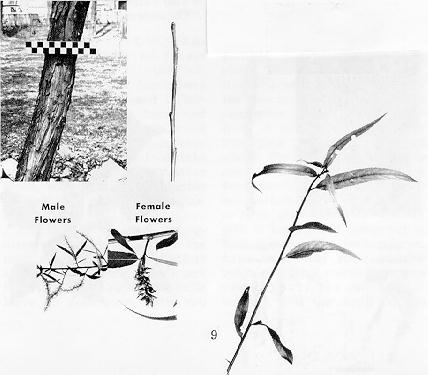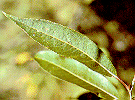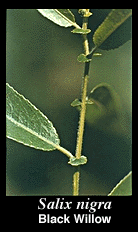Salix nigra
 Black Willow is also called Swamp Willow.
Black Willow is also called Swamp Willow.
Distribution: Throughout the eastern United States, from the Atlantic coast west toMinnesota, Iowa, Nebraska, Kansas, Oklahoma and Texas.
The Tree: Black willow trees reach a height of 140 ft (43 m), with a diameter of 4 ft (1.2 m).
General Wood Characteristics: The sapwood of black willow is light tan, while the heartwood is pale reddish brown to grayish brown. The wood has no characteristic odor or taste. It is soft, but does not splinter when dented; uniform in texture; and weak in bending and crushing.
Like all willows, Black Willows aid in stream bank stabilization. Willows are pioneer, sun loving trees that are the first to become established on sand bars. Only black willow reaches commercial size. The bark of the root is intensely bitter and has been used as an ingredient of tonics to purge the blood. Usually black willow is a rather small tree, but under good conditions it may grow to 70 or 80 feet in height and two or more feet in diameter.
Willow trees are either male or female with flowers of different sexes borne on seperate trees. The female flower hangs in long clusters or aments. The seed is carried far and wide by wind and water.
Light and flexible willow wood is used for wicker-work furniture and basket. It does not split when nailes. Before the discovery of plastics, toys were made from willow. Artificial limbs, packing cases and some furniture parts are also willow products. Its warm brown tones and attractive grain make it a beautiful paneling wood.
 Leaves are
alternate, simple, long and thin.
Leaves are
alternate, simple, long and thin.
The black willow is a large willow, attaining a height of 75 feet and a diameter of 2 feet or more. It has as irregular, open crown and frequently a cluster of main trunks.
 The leaves are narrow (3/8 to 2/4 inch wide) and taper pointed, with long, sharp curved
tips and finely toothed margins. They are shiny light green above, duller below and often velvety
along the midrib. There are prominent leaflike stipules at the base of the leaf stem. The buds are
reddish brown. The twigs are reddish or orange-brown, slender and brittle.
The leaves are narrow (3/8 to 2/4 inch wide) and taper pointed, with long, sharp curved
tips and finely toothed margins. They are shiny light green above, duller below and often velvety
along the midrib. There are prominent leaflike stipules at the base of the leaf stem. The buds are
reddish brown. The twigs are reddish or orange-brown, slender and brittle.
The fruit is a catkin of small, light reddish brown capsules, 1/8 inch long, with tufted seeds. On young branches the bark is yellowish to reddish brown. On larger stems and trunks it is almost black, broadly ridged and shaggy or scaly.
This is the largest and most picturesque of all our willows. It is only one of about 100 kinds of willows occurring in North America. All are very similar in appearance, and generally difficult to identify, even for experts.
Notice that the long, lance-shaped leaves are green on both sides. Often stipules occur at the base of the leaves. Stipules on vigorous shoots persist until autumn. Male and female flowers are borne separately in catkins on different trees.
The Patowatomi Indians made a fine scarlet dye from the roots of this tree. A tea brewed from the roots and bark was used as a substitute for quinine by the pioneers. Even today, willow charcoal is frequently used for manufacturing gunpowder.
Willow wood is soft, light, and weak but highly resistant to splintering and splitting. It is used for crates, charcoal, and artificial limbs.
![]()